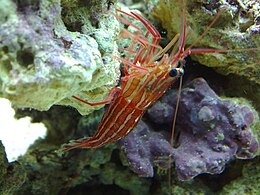Lysmata
Megjelenés
| Lysmata | ||||||||||||||||||||||||||
|---|---|---|---|---|---|---|---|---|---|---|---|---|---|---|---|---|---|---|---|---|---|---|---|---|---|---|
 Lysmata seticaudata
| ||||||||||||||||||||||||||
| Rendszertani besorolás | ||||||||||||||||||||||||||
| ||||||||||||||||||||||||||
| Szinonimák | ||||||||||||||||||||||||||
| ||||||||||||||||||||||||||
| Hivatkozások | ||||||||||||||||||||||||||
A Wikimédia Commons tartalmaz Lysmata témájú kategóriát. |
A Lysmata a felsőbbrendű rákok (Malacostraca) osztályának tízlábú rákok (Decapoda) rendjébe, ezen belül a Lysmatidae családjába tartozó nem.
Rendszerezés
[szerkesztés]A nembe az alábbi 47 faj tartozik:
- csíkos tisztogató garnéla (Lysmata amboinensis) (de Man, 1888)
- Lysmata anchisteus Chace, 1972
- Lysmata ankeri Rhyne & Lin, 2006
- Lysmata argentopunctata Wicksten, 2000
- Lysmata bahia Rhyne & Lin, 2006
- Lysmata baueri Prakash & Baeza, 2017
- Lysmata boggessi Rhyne & Lin, 2006
- Lysmata brevrostrus Wang & Sha, 2018
- Lysmata californica (Stimpson, 1866)
- Lysmata chica Wicksten, 2000
- skarlát tisztogató garnéla (Lysmata debelius) Bruce, 1983
- Lysmata dispar Hayashi, 2007
- Lysmata galapagensis Schmitt, 1924
- Lysmata grabhami (Gordon, 1935)
- Lysmata gracilirostris Wicksten, 2000
- Lysmata guamensis Anker & Cox, 2011
- Lysmata hochi Baeza & Anker, 2008
- Lysmata holthuisi Anker, Baeza & De Grave, 2009
- Lysmata intermedia (Kingsley, 1878)
- Lysmata jundalini Rhyne, Calado & dos Santos, 2012
- Lysmata kempi Chace, 1997
- Lysmata kuekenthali (de Man, 1902)
- Lysmata leptodactylus Gan & Li, 2016
- Lysmata lipkei Okuno & Fiedler, 2010
- Lysmata moorei (Rathbun, 1901)
- Lysmata morelandi (Yaldwyn, 1971)
- Lysmata multiscissa (Nobili, 1904)
- Lysmata napoleoni De Grave & Anker, 2018
- Lysmata nayaritensis Wicksten, 2000
- Lysmata nilita Dohrn & Holthuis, 1950
- Lysmata olavoi Fransen, 1991
- Lysmata parvispinosus Wang & Sha, 2018
- Lysmata pederseni Rhyne & Lin, 2006
- Lysmata philippinensis Chace, 1997
- Lysmata porteri (Rathbun, 1907)
- Lysmata rafa Rhyne & Anker, 2007
- Lysmata rathbunae Chace, 1970
- Lysmata seticaudata (Risso, 1816) - típusfaj
- Lysmata splendida Burukovsky, 2000
- Lysmata stenolepis Crosnier & Forest, 1973
- Lysmata ternatensis de Man, 1902
- Lysmata trisetacea (Heller, 1861)
- Lysmata udoi Baeza, Bolaños, Hernandez & López, 2009
- Lysmata uncicornis Holthuis & Maurin, 1952
- Lysmata vittata (Stimpson, 1860)
- Lysmata wurdemanni (Gibbes, 1850)
- Lysmata zacae Armstrong, 1941
Források
[szerkesztés]- Lysmata Risso, 1816 WoRMS
- Risso, A. (1816). Histoire Naturelle des Crustacés des Environs de Nice. Librairie Grecque-Latine-Allemande, Paris. 175 pp., 3 plates., available online at https://www.biodiversitylibrary.org/page/39428268
- Spence Bate, C. (1888). Report on the Crustacea Macrura collected by the Challenger during the years 1873-76. eport on the Scientific Results of the Voyage of H.M.S. ”Challenger” during the years 1873-76. 24: i-xc, 1-942, Plates 1-157.
- Stimpson, W., 1860a. Prodromus descriptionis animalium evertebratorum, quae in Expeditione ad Oceanum Pacificum Septentrionalem, a Republic Federata missa, Cadwaladore Ringgold et Johanne Rodgers Ducibus, observavit et descripsit. Pars VIII, Crustacea Macrura.— Proceedings of the Academy of Natural Sciences of Philadelphia 1860: 22-47. [pages 91–116 on separate]
- Rafinesque, C.S. (1814). Précis des découvertes et travaux somiologiques de Mr. C.S. Rafinesque-Schmaltz entre 1800 et 1814; ou choix raisonné de ses principales découvertes en zoologie et en botanique, pour servir d'introduction à ses ouvrages futurs. Palerme. 1-55.
- Leach, W.E., 1830a. On three new genera of the malacostraceous Crustacea, belonging to the family Squillidae.— Transactions of the Plymouth Institution 1: 172-175.
- Türkay, M. (2001). Decapoda, in: Costello, M.J. et al. (Ed.) (2001). European register of marine species: a check-list of the marine species in Europe and a bibliography of guides to their identification. Collection Patrimoines Naturels, 50: pp. 284–292
- d'Udekem d'Acoz, C. (1999). Inventory and distribution of the decapod crustaceans from the northeastern Atlantic, the Mediterranean and the adjacent continental waters north of 25°N. Collection Patrimoines Naturels, 40. Muséum national d'Histoire naturelle. Paris. (a katalógusokban formailag hibás ISBN-nel szerepel) ISBN 2-86515-114-10. X, 383 pp.
- Ahyong, S.T. 2010: New species and new records of Caridea (Hippolytidae: Pasiphaeidae) from New Zealand. Pp. 341–357 in
- Anker, A. ; J.A. Baeza & S. De Grave, 2009: A New Species of Lysmata (Crustacea, Decapoda, Hippolytidae) from the Pacific Coast of Panama, with Observations of Its Reproductive Biology. Zoological Studies 48 (5): 682–692.
- De Man, J.G., 1888b. Bericht über die von Herrn Dr. J. Brock im indischen Archipel gesammelten Decapoden und Stomatopoden.— Archiv für Naturgeschichte 53 (3): 289-600, Plates 11-22a.
- Bruce, A.J., 1983e. Lysmata debelius new species, a new hippolytid shrimp from the Philippines.— Revue française d’Aquariologie 9 [for 1982]: 115-120.
- De Grave, S. & C.H.J.M. Fransen. (2011). Carideorum catalogus: the recent species of the dendrobranchiate, stenopodidean, procarididean and caridean shrimps (Crustacea: Decapoda). Zool. Med. Leiden. 85(9): 30.ix.2011: 195-589 figs 1-59.
- Liu J.Y. [Ruiyu] (ed.). (2008). Checklist of marine biota of China seas. China Science Press. 1267 pp.


